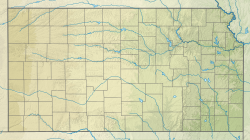 Walnut River, Arkansas City, Kansas | |
| Alternative name | Tzanoa |
|---|---|
| Location | Arkansas City, Kansas, United States |
| Region | Great Plains |
| Type | Settlement |
| Length | about 5 miles long |
| History | |
| Founded | c. 1450 |
| Abandoned | c. 1700 |
| Cultures | Wichita people |
| Site notes | |
| Archaeologists | Donald Blakeslee |
| Public access | Accessible to the public. |
 |
| Mound Builders |
|---|
| Polities |
| Archaeology |
| Religion |
Etzanoa is a historical city of the Wichita people, located in present-day Arkansas City, Kansas, near the Arkansas River, that flourished between 1450 and 1700. [1] Dubbed "the Great Settlement" by Spanish explorers who visited the site, Etzanoa may have housed 20,000 Wichita people. [2] The historical city is considered part of Quivira. [3]
Contents
- Archaeological research
- Rayado Indians
- Spanish chronicles
- Jusepe, 1594/95
- Oñate, 1601
- Tours
- See also
- Notes
- References
- External links
When Spanish conquistador Francisco Vásquez de Coronado's expedition visited central Kansas in 1541, he dubbed the Wichita settlements "Quivira". [4] [1] The Umana and Leyba expedition visited the Etzanoa site in 1594 and Juan de Oñate visited there in 1601. They recorded the inhabitants as being the Rayados. In Spanish Rayados means "striped." The Wichita people were noted for the straight lines they tattooed onto their faces and their bodies.
In April 2017, the location of Etzanoa was finally discovered when a local teen found a cannonball linked to a battle near present-day Arkansas City that took place in the year 1601. Local researchers used this artifact to pinpoint the location of Etzanoa. [5]

